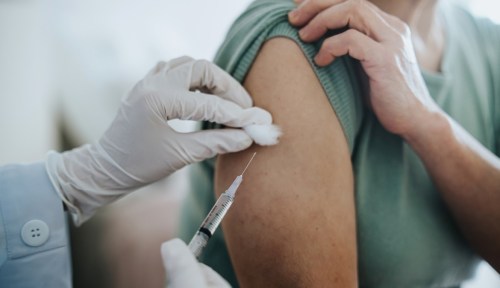Grappling with infertility can often feel like shaking a Magic 8 ball over and over again—no matter how hard you try or how many times you ask, all you get are super vague, not-helpful predictions about outcomes. There are so many variables that can impact fertility, from age to health conditions to just simple timing, that determining when or how a person will get pregnant a bit more complex than it was presented in high school health class. (You know, sperm + egg = baby.) Even a person who is theoretically doing all of the “right” things could feel completely in the dark about what’s going on (or not going on) with their body.
That’s why experts typically recommend people struggling to get pregnant come in for fertility testing to put some of the confusing question marks into more digestible concretes. “It’s always good to meet with and talk to your gynecologist when trying to get pregnant—they can help you move forward,” says Chantel Ianthe Cross, M.D., associate director of reproductive endocrinology and infertility fellowships at John’s Hopkins Medicine.
Jennifer Kulp-Makarov, M.D., an OB/GYN, reproductive endocrinologist, and infertility specialist at New Hope Fertility Center in New York City, suggests people age 35 or younger should give themselves at least a year of trying before seeking out help from a doctor. Those between the age of 35 and 40 should consider waiting about six months before seeing a fertility specialist, while those 40 and older probably want to see one before they even start the process. “Come in sooner if you have problems like painful periods or irregular menstrual cycles,” she adds.
A person’s first fertility consultation includes a fertility test—but rest assured there are no Scantrons involved. If you’re going to a doctor and not using an at-home kit, a fertility test for women will typically will set you back between $50 and $1000, depending on what labs are ordered and what kind of insurance you have. But as for what to expect and what you could learn for it…we’ll let the doctors take it from here.
You and your partner will go over your health histories
Right off the bat, your doctor will probably ask you lots of questions about your cycle, like how long it lasts and how much time passes between periods, to get an idea of how regular you are. This is when period tracking can be super useful; you can use any of these nine options or a device like Fitbit or Apple Watch and bring in the data to go over with your doctor. It’s also important to know your personal and family medical history, says Dr. Cross, so come prepared to talk about it. Your doctor will probably ask you about any past pregnancies, medications or illnesses you’ve had, and if there have been any birth defects in your family—all of which can potentially impact your fertility.
If you have a male partner, both experts say he should join you for the appointment because he’ll need a check-up too. “About 40 percent of the time, infertility can be on the male side,” says Dr. Kulp-Makarov. A dad’s lifestyle can play a role in fertility—smoking and marijuana use, for example, can have an effect on sperm, so the doc is likely to ask your S.O. about his daily habits. Docs will also give him a semen analysis to examine sperm count, how they’re moving, and their shape to ensure that his swimmers are in the best shape possible to fertilize your eggs.
Another fertility testing option: Kindbody’s mobile testing bus:
Your doctor will order some bloodwork
A simple blood test can tell your doctor a lot about your body, including whether you have normal thyroid function and if you’re immune to certain conditions like rubella or chicken pox, says Dr. Cross. You wouldn’t get the vaccine for those illnesses once you’re pregnant, so you want to make sure you’re up to date to avoid getting sick and suffering complications when pregnant.
Drawing blood also allows doctors to check a few hormones, including anti-Müllerian hormone (AMH), a protein hormone produced by cells inside the ovaries. “The eggs we have produce the AMH hormone, so the more eggs you have, the higher that hormone level will be,” says Dr. Cross. (Lower levels of AMH means you have fewer eggs to work with, which could be a sign of imminent menopause.) Bloodwork will also determine levels of follicle stimulating hormone (FSH), another crucial hormone for ovarian function.
While AMH doesn’t necessarily predict whether you can get pregnant on your own, Dr. Cross says your results can help your practitioner know how well you’d respond to fertility treatments. If results show a low egg supply, Dr. Kulp-Makarov adds, doctors might choose to go with a more aggressive fertility treatment, but they’ll be able to lay out your options.
Bloodwork can also look out for hormone imbalances in general, say Dr. Kulp-Makarov. For instance, the test might show a person has elevated testosterone levels, which could be a sign of polycystic ovarian syndrome (PCOS), which can impact fertility.
You’ll likely get a pelvic exam and ultrasound
Like your annual gyno appointment, your doctor will probably want to check the uterus by performing a pelvic exam. “A painful pelvic exam can be a sign of fibroids or endometriosis,” Dr. Cross says. Depending on where you are in your cycle, the gyno might also check on your cervical mucus to see if you should be ovulating.
Then you’ll probably have an ultrasound so docs can learn more about your internal reproductive organs. The imaging will reveal the shape of the uterus (better than what can be determined in a standard pelvic exam) so the doc can see if there any abnormalities that could make conception harder, says Dr. Cross, like cysts, tilting, scar tissue, or other masses. The ultrasound can also give doctors a more concrete idea of egg supply beyond your AMH levels—in fact, a fertility doctor should be able to count the number of eggs you have, says Dr. Kulp-Makarov.
“Most women don’t have pain [during the ultrasound], but some people are sensitive to any vaginal manipulation,” says Dr. Cross, so prepare for potential discomfort. It can also be a difficult exam for people who have experienced trauma or abuse since it’s inherently a bit more invasive; don’t be afraid to communicate clearly with your doctor about what you are and are not comfortable with.
You could have your fallopian tubes checked
Right along with your ovaries and uterus, your fallopian tubes play a vital role in pregnancy—that’s where your egg is released by the ovary, and it’s where fertilization takes place. To check the health of your fallopian tubes, doctors often perform a test known as hysterosalpingogram or HSG. This is done during the first half of your cycle, and involves the doctor injecting a contrast dye into the uterus and then taking X-ray images to check that the dye goes into the uterus and out the fallopian tubes. Fibroids might show up on this exam, which block the tubes and sometimes require removal. Conditions like endometriosis, chlamydia, and gonorrhea can all lead to scarring of the fallopian tubes, so if that’s the case, doctors will know to potentially avoid using the tubes in fertility treatments, says Dr. Kulp-Makarov. The whole process takes just about five minutes and can be a little cramp-inducing for some people; both doctors recommend taking an OTC pain reliever before your appointment just in case.
Some offices also offer what’s known as a saline infusion sonogram or SIS, a test you’d usually come back in for after your initial appointment, says Dr. Cross. It involves an ultrasound and a catheter that goes into the vagina, through the cervix, and up to the uterus, where doctors inject a saline solution. This gives insight into the structure of the uterus, but skilled practitioners can also use it to check the fallopian tubes, she says.
You can also opt for genetic testing
While some women get a genetic test while they’re pregnant, others have the option to run the test during their initial fertility evaluation (called carrier screening). The doctors will scan for about 300 diseases via a blood test, says Dr. Kulp-Makarov, to make sure both parents don’t have the same genetic mutation. If they’re both carriers of the same disease, that can increase the chances of the child having it, too. For example, if one parent is carrying the gene for cystic fibrosis (a genetically-inherited disease that affects the lungs and digestive system), they’ll test the other parent to see if they have the same gene. If they do, that means the child has a one in four chance of getting cystic fibrosis. With this info, doctors can then make sure to test the embryo during IVF to make sure the kid won’t have the gene (or the disease). Per the NIH, this can cost up to $2,000, depending on how in-depth the screening is.
Curious about other aspects of fertility? Here’s the lowdown on common myths about foods for fertility. And here are some general FAQs about fertility everyone should know.
Sign Up for Our Daily Newsletter
Get all the latest in wellness, trends, food, fitness, beauty, and more delivered right to your inbox.
Got it, you've been added to our email list.











